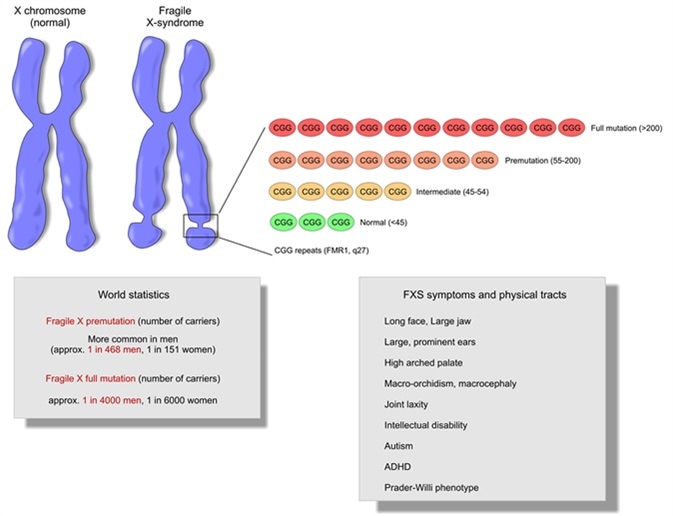Fragile X syndrome (FXS) is a genetic condition that shows typical physical attributes along with behavioural and developmental anomalies in children. It is also called Martin Bell syndrome or a Marker X syndrome.
FXS presents with delayed speech and language development along with some level of intellectual disability. These can also include ADHD, anxiety and autistic-like social disability. Although physical attributes are somewhat subtle in young infants, they become more prominent with age. These include sunken eyes (midface hypoplasia) with a long face, double jointed thumbs, an arched palate, flat feet and large ears. The physical manifestations of FXS are not always present in their entirety.

Fragile X syndrome, a genetic disorder of the X chromosome (FMR1 gene) and main symptoms and pathologies correlated. Image Credit: ellepigrafica / Shutterstock
Genetics and Pathophysiology of FXS
FXS is the most common cause of genetic learning disability. FXS is causes by mutations (faults) to a gene on the X chromosome (FMRI1). In this mutation, patients can have up to 200 or more repeated expansions of CGG, whereas the normal population would have no more than 40 repeats. This repeat expansion silences the gene rendering it functionless. As a consequence, normal brain development is impacted i.e. the ability for neural connections through synaptic plasticity is impaired.
FXS is more common in boys than it is in girls, since boys carry a single X chromosome, they are more severely affected than girls who may have one normal FMR1 gene on the second healthy X chromosome. Affected girls may have only mild disabilities compared to boys. Affected girls however, are carriers of the condition and they may pass it on to their male offspring.
Some affected persons may also have a small change or mutation and thus may be carriers. They pass on the full mutation to the next generation.
Diagrammatic Representation of the Transmission Pattern of Fragile X
How common is FXS?
Fragile X affects about 1 in 4000 men and around 1 in 6000-8000 women. It affects all races and ethnicities. It may be carried by those with mild affliction of the FMR1 gene and may be passed on to the offspring.
In the UK, the overall prevalence of FXS in the general population is 2.3 per 10,000 or 1 in 4,425. Two to four times as many females as males are carriers of the genetic premuation (50 or above CGG repeats). Only a third of females carry the abnormal gene responsible for learning disabilities.
Symptoms of FXS
The most common symptom of the FXS is intellectual impairment. There is a wide range of difference in IQ amongst those affected. Some patients may have a normal IQ and shows no sign of Fragile X, whereas some may have severe learning difficulties. The degree of impairment is dependent on the extent of CGG repeats to the FMR1.
In addition to intellectual deficits there are also emotional and behavioural problems. These may include features of:
- Attention deficit disorder
- Hyperactivity
- Impulsivity
- Anxiety
- Mood swings
There are typical facial features and physical attributes of FXS. These include a long face, large ears, flat feet, high forehead, large testicles, large jaws, and extremely flexible joints.
Diagnosis of FXS
Fragile X can be diagnosed using DNA analysis to confirm mutations to FMR1. DNA can also be checked in an unborn foetus as well. This is done by taking a sample of the amniotic fluid or tissues from within the womb, called chorionic villus sampling or amniocentesis, and can be performed at about 11 weeks of pregnancy.
Management & Treatment of FXS
As of now there is no cure or treatment for FXS. Children with FXS need behavioural therapy, counselling, emotional and educational support. Children with delayed speech and language development may need the help of speech and language therapist.
Behavioural therapy is useful for children with attention deficit, impulsivity and other behavioural problems. Some children may be able to cope well in mainstream schools. However, those with significantly impaired intelligence and learning difficulties may benefit from special schools to meet their special educational needs.
Medication is also used to treat or manage some of the secondary symptoms that present variably across patients. These medications include stimulants that target attentional deficits and hyperactivity (ADHD medications). Sometimes SSRIs (antidepressants) may also be used to treat anxiety and mood swings. For those suffering from seizures (15% of boys) anticonvulsants may also be used.
Recent animal research has shown that drugs that are mGluR5 antagonists (block glutamate receptors in the brain) can alleviate synaptic problems therefore enhancing cognitive, intellectual and some behavioural symptoms. These experimental drugs show promising results, but need to be fully investigated in larger clinical trials before assessing their efficacy.
Further Reading